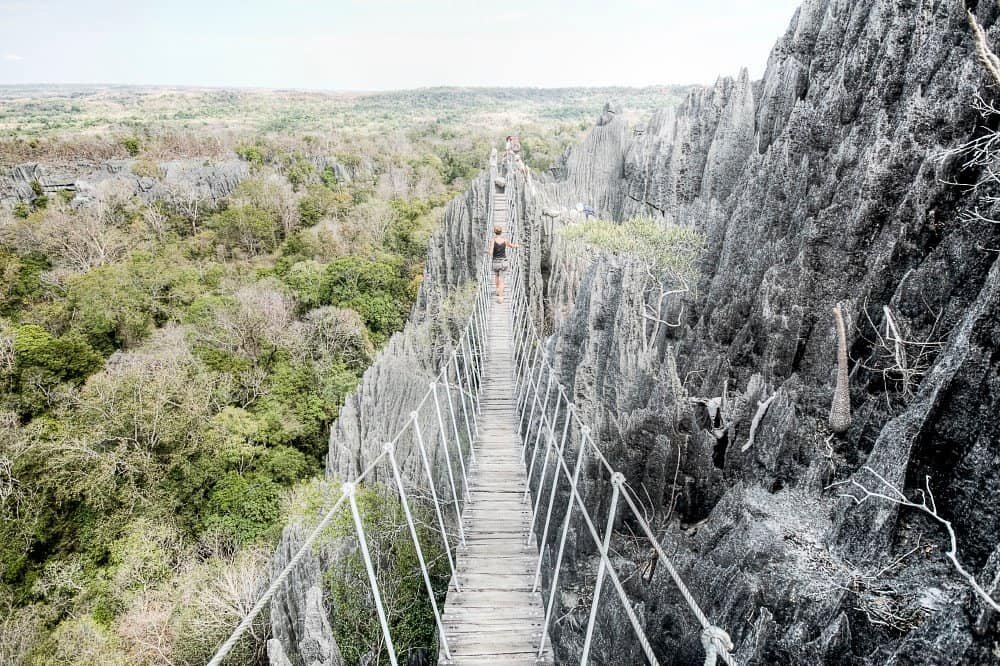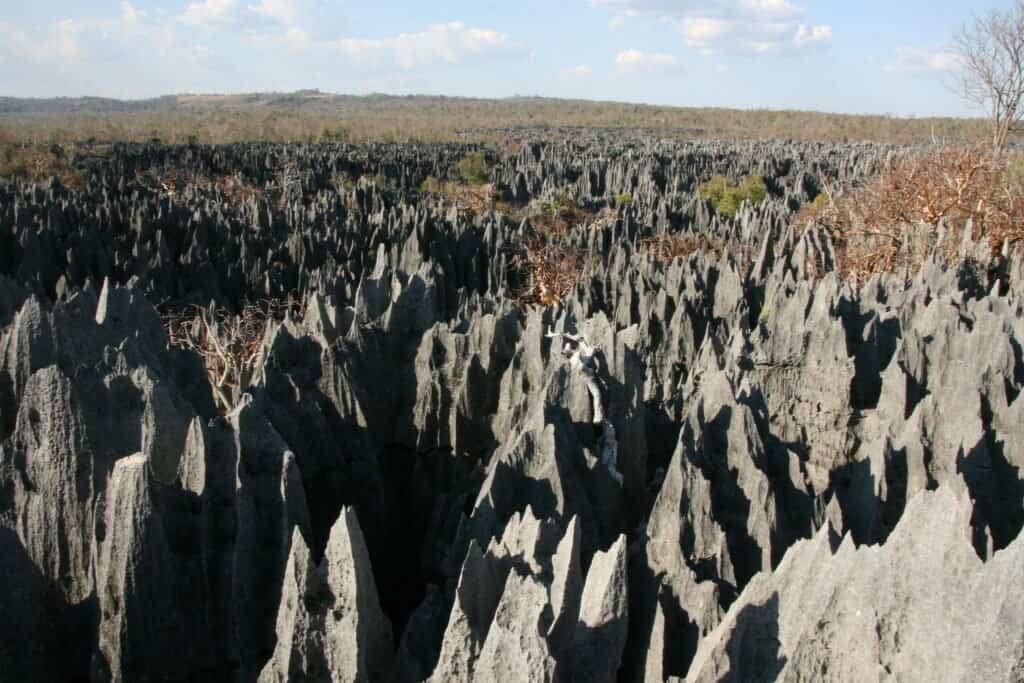
Madagascar, the world’s fourth-largest island, is a land of diverse landscapes, unique wildlife, and rich cultural heritage. Among its many natural wonders, the mysterious stone forests of Tsingy de Bemaraha stand out as a truly extraordinary destination. In this article, we will take you on a journey through the fascinating Tsingy de Bemaraha National Park, exploring its history, geology, wildlife, and how you can visit this remarkable place.
What is Tsingy de Bemaraha?
Tsingy de Bemaraha is a UNESCO World Heritage site located in the Melaky Region of western Madagascar. The term “tsingy” is derived from the Malagasy word “mitsingitsingy”, which means “walking on tiptoes”. This name perfectly describes the unique geological formations that make up the area – a vast labyrinth of razor-sharp limestone pinnacles, some reaching heights of over 30 meters.
History and Geology
The formation of the Tsingy de Bemaraha dates back millions of years, beginning with the deposit of marine sediments in the shallow sea that once covered the region. Over time, these sediments were compressed into layers of limestone, which were then uplifted by tectonic forces. Erosion by rainwater gradually sculpted the limestone into the jagged, needle-like pinnacles we see today.
The Tsingy de Bemaraha covers an area of more than 1500 square kilometres, consisting of two main areas: the Great Tsingy and the Little Tsingy. The Great Tsingy is the largest and most impressive part, with towering pinnacles, deep canyons, and fascinating cave systems. The Little Tsingy is smaller and more accessible but still offers a spectacular landscape of limestone formations.
Unique Wildlife
Madagascar is renowned for its endemic wildlife, and this place is no exception. The region is home to a wide variety of species, many of which have adapted to the harsh conditions of the stone forests. Some of the wildlife you may encounter during your visit include:

- Lemurs: Madagascar is famous for its lemurs, and the Tsingy de Bemaraha is home to several species, including the Decken’s sifaka, red-fronted brown lemur, and the critically endangered Sambirano mouse lemur.
- Birds: Over 100 species of birds have been recorded in the area, including the endangered Madagascar fish eagle, crested ibis, and the rare Madagascar wood rail.
- Reptiles and amphibians: The Tsingy de Bemaraha is a haven for reptiles and amphibians, with over 30 species of frogs, chameleons, and snakes found within its boundaries. Look out for the iconic panther chameleon, the leaf-tailed gecko, and the bizarre-looking satanic leaf-tailed gecko.
- Mammals and other wildlife: Several species of bats inhabit the caves of Tsingy de Bemaraha, while tenrecs, mongoose, and fossas can also be found in the area.
Flora and Vegetation
The vegetation in Tsingy de Bemaraha is just as unique as its wildlife, with numerous plant species found nowhere else in the world. The harsh limestone terrain has led to the development of specialised plant communities, including various species of succulents, orchids, and palms. The endemic Bemaraha woolly lemur’s bamboo (Cephalostachyum bemarahaense) is a particularly fascinating plant, as it is the primary food source for the Decken’s sifaka.
Visiting Tsingy de Bemaraha
How to Get There
Reaching the site can be a bit of an adventure in itself, as the area is quite remote. The most common route involves flying into the capital city of Antananarivo and then taking a domestic flight to Morondava. From Morondava, it’s a long, bumpy drive to the Tsingy de Bemaraha – typically taking around 10 hours. Alternatively, you can organise a private charter flight directly to the Tsingy de Bemaraha, but this option can be quite costly.
Best Time to Visit
The best time to visit the Tsingy de Bemaraha is during the dry season, which runs from April to November. During this time, the weather is generally more pleasant, and the roads are more navigable. The park is closed during the rainy season (December to March) due to poor road conditions and the risk of flooding.
Accommodation
There are several lodges and campsites located near the site, offering a range of accommodation options. Some popular choices include the Tsingy Lodge, Orchidée de Bemaraha, and the Olympe du Bemaraha. These lodges provide comfortable rooms, excellent service, and knowledgeable local guides who can help you make the most of your visit to the Tsingy de Bemaraha.
What to Expect

Visiting the Tsingy de Bemaraha can be a challenging but rewarding experience. The terrain is rugged, and exploring the stone forests often involves climbing steep ladders, navigating narrow passages, and crossing suspended bridges. It is essential to wear sturdy shoes and comfortable clothing, and be prepared for a physically demanding adventure.
Activities and Tours
There are several options for exploring the Tsingy de Bemaraha, depending on your interests and level of fitness:
- Guided walks: The most popular way to experience the area is through guided walks, which can range from short, easy strolls to more challenging full-day hikes. Your guide will take you through the labyrinth of limestone pinnacles, pointing out interesting features and wildlife along the way.
- Cave exploration: The Tsingy de Bemaraha is home to an extensive network of caves, which can be explored as part of a guided tour. These subterranean adventures provide a unique perspective on the region’s geology and offer the chance to see some fascinating cave-dwelling wildlife.
- Birdwatching: With over 100 species of birds found in the area, Tsingy de Bemaraha is a fantastic destination for birdwatching. Guided birdwatching tours can be arranged, allowing you to observe the diverse avian species that call this unique landscape home.
- Canoe trips: The Manambolo River runs alongside the area and offers a different perspective on the stone forests. Canoe trips can be arranged, taking you through picturesque gorges and past impressive limestone cliffs.
Conclusion
The mysterious stone forests of Tsingy de Bemaraha are a must-visit destination for anyone interested in unique landscapes, endemic wildlife, and off-the-beaten-path adventures. With a fascinating history, remarkable geology, and an array of exciting activities to choose from, a trip here is sure to be an unforgettable experience. So why not start planning your journey to this remarkable corner of Madagascar today?

